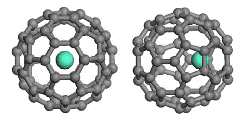Chemistry, Department of: Faculty Series

Xiao Cheng Zeng Publications
ORCID IDs
Lai-Sheng Wang: http://orcid.org/0000-0003-1816-5738
Xiao Cheng Zeng: http://orcid.org/0000-0003-4672-8585
Document Type
Article
Date of this Version
2016
Citation
Nanoscale, 2016, 8, 9805–9814
DOI: 10.1039/ c6nr01506a
Abstract
Besides the size and structure, compositions can also dramatically affect the properties of alloy nanoclusters. Due to the added degrees of freedom, determination of the global minimum structures for multi-component nanoclusters poses even greater challenges, both experimentally and theoretically. Here we report a systematic and joint experimental/theoretical study of a series of gold–aluminum alloy clusters, AuxAly−(x + y = 7,8), with various compositions (x = 1–3; y = 4–7). Well-resolved photoelectron spectra have been obtained for these clusters at different photon energies. Basin-hopping global searches, coupled with density functional theory calculations, are used to identify low-lying structures of the bimetallic clusters. By comparing computed electronic densities of states of the low-lying isomers with the experimental photoelectron spectra, the global minima are determined. It is found that for y ≥ 6 there is a strong tendency to form the magic-number square bi-pyramid motif of Al6−in the AuxAly−clusters, suggesting that the Al–Al interaction dominates the Au–Au interaction in the mixed clusters. A closely related trend is that for x > 1, the gold atoms tend to be separated by Al atoms unless only the magic-number Al6−square bi-pyramid motif is present, suggesting that in the small-sized mixed clusters, Al and Au components do not completely mix with one another. Overall, the Al component appears to play a more dominant role due to the high robustness of the magic-number Al6−square bi-pyramid motif, whereas the Au component tends to be either “adsorbed” onto the Al6−square bi-pyramid motif if y ≥ 6, or stays away from one another if x < y < 6.
Includes supplemental files.


Comments
This journal is © The Royal Society of Chemistry 2016. This article is licensed under a Creative Commons Attribution-NonCommercial 3.0 Unported Licence.